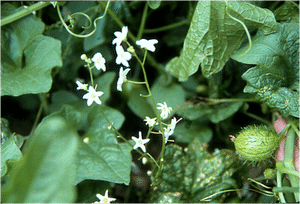 Common name: bigroot wild cucumber, manroot
Common name: bigroot wild cucumber, manroot
Scientific name: Marah oreganus
Plant family: Cucurbitaceae
Description: Marah oreganus is a climbing perennial from swollen woody roots. The stems are leafy and herbaceous and bear tendrils. The leaves of Marah oreganus are alternately oriented, quite large (15-20 cm across), irregularly palmately lobed, and are rough and hairy on top, while sparsely hairy or hairless on the bottom. Its flowers are whitish, bell-shaped and about 1 cm across. The male and female flowers of Marah oreganus appear on the same plant, otherwise known as monoecious. The male flowers appear in narrow stalked clusters, while the female flowers appear solitary and are short stalked. The fruits of Marah oreganus are football-shaped bladders that are inflated and somewhat fleshy. Eventually, these fruits dry and burst irregularly. Inside, the fruits are fibrous and netted with 2-4 chambers. There are 1 to 2 large (2 cm long), smooth seeds per chamber. [1]
Habitat and Range: Marah oreganus is commonly found at low elevations in moist fields, clearings, thickets, bottomlands, and open hillsides.1 It ranges from west of the Cascades from California to British Columbia.[2]
Historical and Contemporary Uses: The Squaxin people of the Southern Puget Sound mashed the upper stalk in water and bathed aching hands in the mixture to alleviate the ache.[3]The Chinook of the lower Columbia River mashed the fruit in order to create a poultice to heal cuts.[1]
Outside of these historical uses, little information exists about the contemporary uses of Marah oreganus.
Photo: http://www.markrshepard.net/WeedsOfOregon/Plant/Western%20wild%20cucumber–Marah%20oreganus–m.jpg

